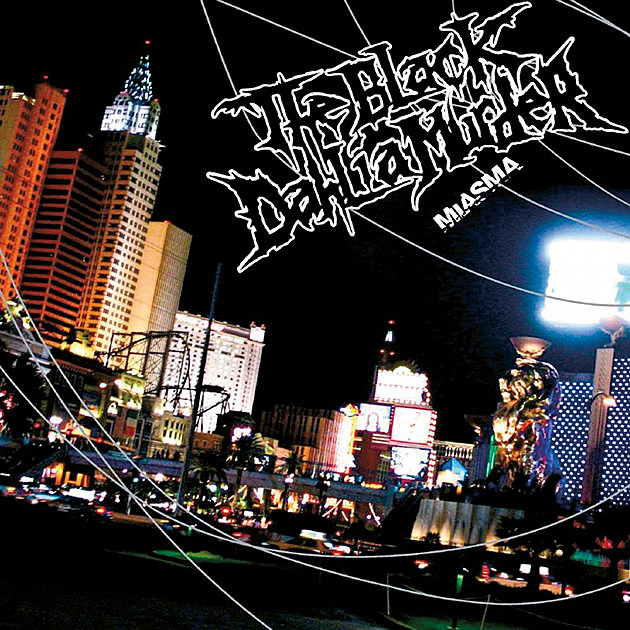
The Black Dahlia Murder's Miasma Turns 10
…
Miasma was released on July 12, 2005
…
It was around ten years ago or so, that I was perusing the aisles at the Newbury Comics in Warwick, Rhode Island, killing some time between high school and work. As this time sat comfortably between the fall of cassette and resurgence of vinyl, the red and black shelves were stocked full CDs, each alphabetized and with no division in genres. At that time, my tastes were in a state of transformation: I’d recently begun to delve into the ore that lay beneath Slipknot, a band which, like many young men circa 2004, I felt were the pinnacle of “heavy.”
On almost a whim, the jagged logo of Detroit’s The Black Dahlia Murder caught my attention, this time duly emblazoned across their 2003 debut, Unhallowed. The artwork was nothing overly striking in comparison to other death metal covers, such as the band’s more recent albums or anything associated with Cannibal Corpse and Suffocation, but the simplicity of the Lovecraftian tentacles emerging from a misty abyss to strangle that aforementioned logo caught me too with that ensnaring simplicity.
That album, while memorable as one of the first metal acts I listened to besides Slipknot, was not as impactful on my musical tastes as its sequel, 2005’s Miasma. The Black Dahlia Murder’s sophomore outing served as that gateway drug to extreme metal for me, with obsessions with bands like Lord Worm-era Cryptopsy, Emperor and Dissection following in short order. Miasma’s release was timed with The Black Dahlia Murder’s stint on that year’s Ozzfest, which played at the Worcester Palladium. As an aside, this fest was my first metal concert and considering Black Sabbath and Iron Maiden were headliners, as a fledgling fan of the genre, this was quite the first-time experience. BDM’s performance was feral, the dueling growl-screech of Trevor Strnad piercing the mid-summer humidity like a dulled but pointed blade. The guitars pummeled me in tune with the ever-widening most pit, where age seventeen, skinny-ass me held his own with sweat-hogs twice my size. In the process, I took a hit to the face—nothing too messy save for a slight crimson tang in my mouth and an internal note that I was hooked. Following their set, I went to their booth and scooped up a Miasma CD for a cheap $10.
Upon hearing Miasma, among my first reactions was to draw comparisons between it and Unhallowed. The melodicism sweeping across tracks like “Elder Misanthropy” and “Closed Casket Requiem,” was reigned in on Miasma, notably on tracks like “Flies” and “Miscarriage.” What had hooked me most on their debut was its adherence to hardcore structures and the accompanying energy. In contrast, Miasma smothered those foundations into near unrecognizability with crushing melodic death metal a la At the Gates and Dissection. Miasma‘s guitar tone is what piqued my attention first, with its sinister undercurrent frequently impaled by by solos waivering between Unhallowed’s light and accompanying dark. Since seeing it performed at Ozzfest, “A Vulgar Picture” has remained the album’s standout track, in which Miasma’s aforementioned best qualities are all accounted for.
In spite of its bleaker tone, BDM’s second album found the band presenting itself in a less serious light on tracks like “Statutory Ape,” (the video for which memorably featured a man in a gorilla suit involving himself in all forms of debauchery). There’s even a song called “Dave Goes to Hollywood.” “A Vulgar Picture” was itself bookended with a film clip questioning the song’s moral taste. Whereas Unhallowed and their demos had featured tentactles and bats, Miasma could’ve come across as some mid-aughts party album if not for BDM’s tattered logo. In short, much of what made Miasma memorable was that it showcased of a band that didn’t take itself too seriously, while also prefacing what could be their best work, 2007’s Nocturnal.
Following Nocturnal, BDM released with a string of albums that each felt more like business as usual than unique entries in a growing catalog. What separated their first three albums from the preceding three was a sense of newness that came with each entry, with Miasma being their flagship record, boasting the band’s signature sinister melodicism and bleak humor, while combining their obsessions with classical horror and death metal tropes.
They did something right to corrupt my impressionable young mind; one my earliest tattoos was their logo on my right calf. It’s still there, like a lingering cosmic horror, spewing acidic, cathartic nostalgia.
…
…












